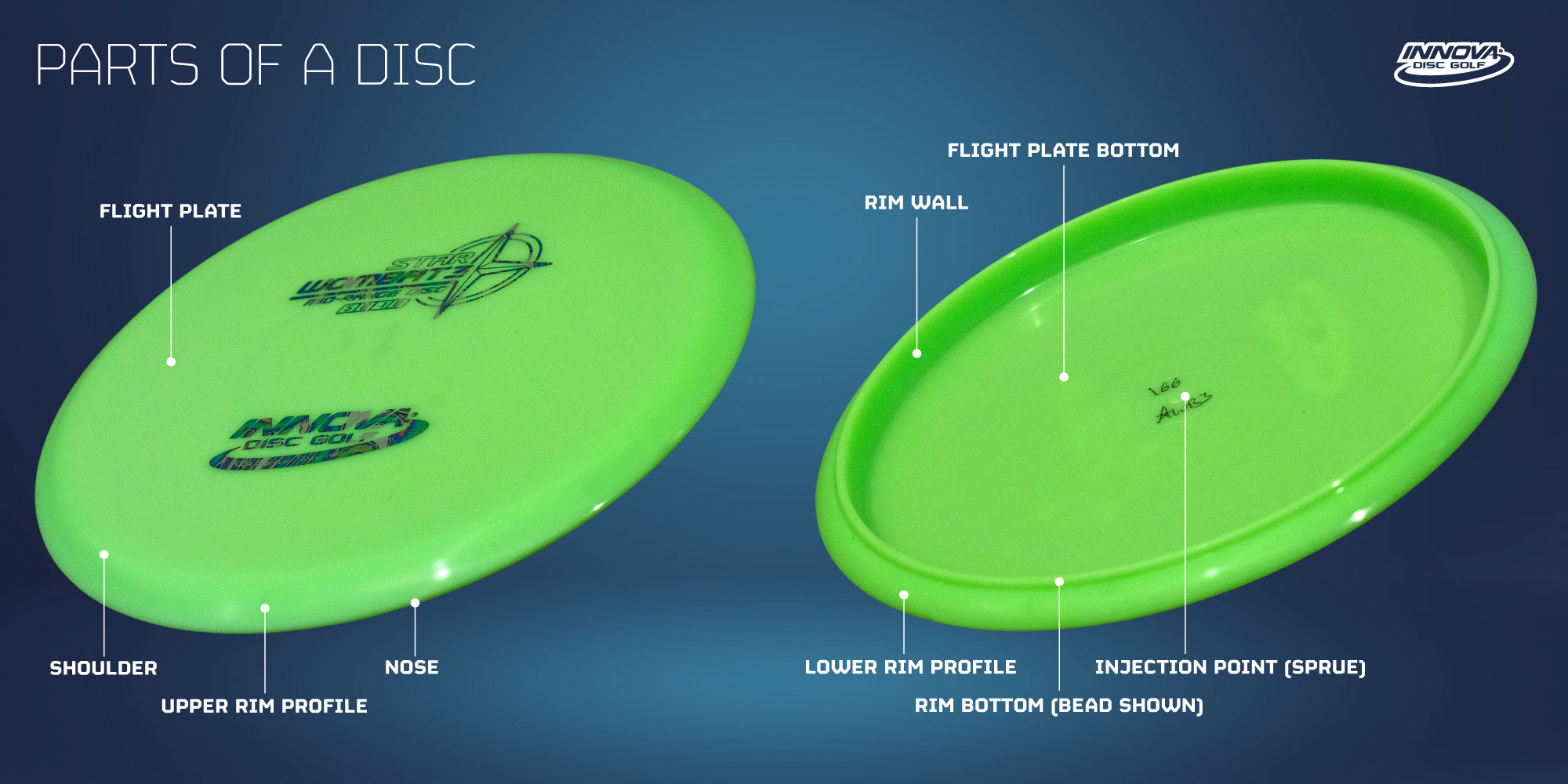Anatomy of a Disc Golf Disc
Though the design of a flying disc may seem relatively simple, there is a lot of science that goes into the architecture of each mold. It’s more than just a plastic circle that magically floats through the air. Disc golf discs are molded with certain aerodynamic qualities and features to achieve very specific flight characteristics.
Some differences are clear when the disc flies. You can easily see what makes a flatter, sharper-edged distance driver disc type different from a putter with a rounded edge and deep rim. One disc flight is designed to cut through the air and achieve maximum distance when thrown at high speeds. The other is designed for optimal control on short approach shots and putts.

Let’s take a look at some of the basic points of anatomy on all disc golf discs, including mini marker discs:
Flight Plate
The primary surface area of a disc is known as the flight plate. It’s the center of the disc. The upper flight plate is what you see when you look at the front of the disc. The bottom flight plate is the portion underneath. Both can be shaped with different thicknesses of plastic and amount of dome to provide different levels of glide or shot-shaping ability.
Injection Point
At the very bottom center of the disc, you will find the injection point (also known as the sprue). This is where the plastic is injected into the molding machine and then shaved off during final production. The top side of the injection point is often called the “button.”
Rim
The rim is the outer edge of the disc and will have the biggest impact on a disc’s speed and how it flies at high and low speeds (i.e. overstability vs. understability). The rim itself has several key components that can all vary greatly from disc to disc. Each mold produced by Innova has a unique combination of rim characteristics that determine the flight numbers (speed, glide, turn, fade) and will give you a different feel in hand.
Nose—The actual edge of the disc, which may be rounded or beveled to affect speed.
Upper Rim Profile—The shape of the top side of the rim between the nose and flight plate.
Lower Rim Profile—The shape of the lower outer rim.
Shoulder—The connection between the rim and the flight plate, which sometimes contains extra plastic or a pronounced “thumb track.”
Rim Wall—The mostly vertical surface of the inside rim (where you grip the disc)
Bead—Some putters and mid-range discs will have a bead, which is a defined raised edge at the bottom of the disc, where the lower rim profile meets the rim wall. This can affect the disc’s flight characteristics to some extent, but is also more of a grip/feel preference for some disc golfers. On the disc golf course, some players like a putter with a pronounced bead. Some don’t.
Thumb Track—Some Innova putt and approach discs like the Rhyno or Pig feature a thumb track, which will either be a raised or lowered shoulder along the upper rim profile. The Sonic has more of a grooved thumb track like you might find on a normal catch or ultimate disc. Again, it is a personal preference of some players who like the grip and control provided by a disc with a defined thumb track.
Pop-Top vs. Puddle-Top
You will notice that some discs have a much more “domey” profile when you look at them from the side. Discs with more dome (especially distance drivers and fairway drivers) tend to offer more glide, but also a bit more stability. This is why you often hear pros talking about looking for a good “pop-top” disc with a lot of dome and a flight plate they can pop in with their thumb while ripping a max distance throw.
A “puddle-top” disc is just the opposite. Its profile may be board flat or sometimes even a little concave on top. This can take away some stability and glide, but usually offers more control (especially in a headwind). And like with many other disc anatomy characteristics, sometimes it is just a feel thing. Some players like the feel of domey discs. Some don’t. Some like domey drivers, but prefer puddle-tops on their mids.
Understanding the different parts of a disc golf disc and how they may affect its feel and flight path can help you when figuring out which discs might be right for your game.
